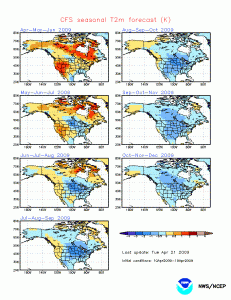A Short Summer Ahead?
Tuesday, April 21st, 2009Wednesday is slated to be the last day of the relatively cooler than normal temperatures we have seen for the first three weeks of April.  Temperatures will rise to the upper 70s, and will reach the 80s by the weekend. It’s likely to stay warmer than normal for the next few weeks, as the first real Bermuda High takes control over the southeastern United States.
Temperatures will rise to the upper 70s, and will reach the 80s by the weekend. It’s likely to stay warmer than normal for the next few weeks, as the first real Bermuda High takes control over the southeastern United States.
In the long run, though, May could be the warmest month through the end of the summer, relative to normal. The image at right shows the latest modeling by the CFS, or coupled forecast system. (Click to enlarge the map). It shows temperatures becoming steadily cooler after a slightly warmer than normal May in the Southeast, and much cooler than normal for the eastern half of the country in July, August and September
 The trend through the end of the year points to colder than normal weather as well, as can be seen by the second graph, which shows forecast temperature anomalies by three month period through the end of the year, by which time virtually the entire country, except for the San Francisco Bay area and much of New England should be cooler than normal.
The trend through the end of the year points to colder than normal weather as well, as can be seen by the second graph, which shows forecast temperature anomalies by three month period through the end of the year, by which time virtually the entire country, except for the San Francisco Bay area and much of New England should be cooler than normal.
Tornado Reports
Numerous confirmed tornadoes stuck north and central Georgia over the last ten days. On Friday, April 10th, twelve confirmed tornadoes and two suspected tornadoes touched down, with the bulk of them stretching from Columbus, through Americus and Cordele. Additional touchdowns were reported in Jasper and Sparta.
Then on April 19th, there were two more tornadoes, one again in the Columbus area, and the other in Cherokee County. Only one injury was reported in the April 10th incident, and two injuries were reported in the April 19th incident.
Sphere: Related Content
